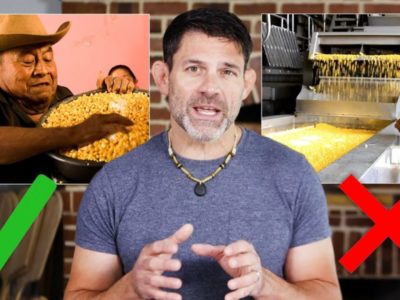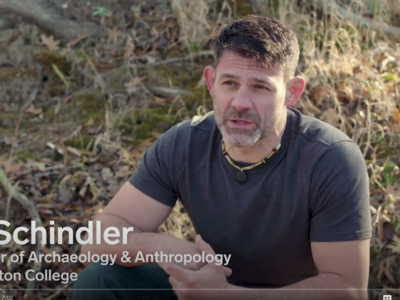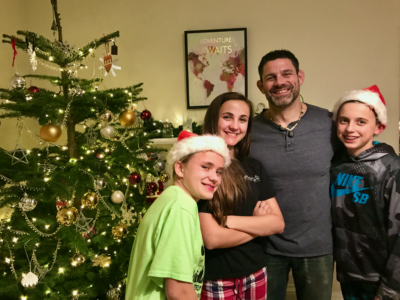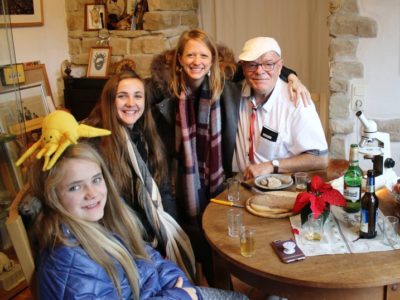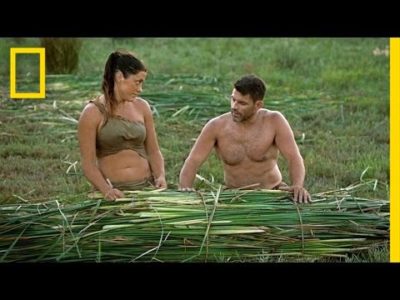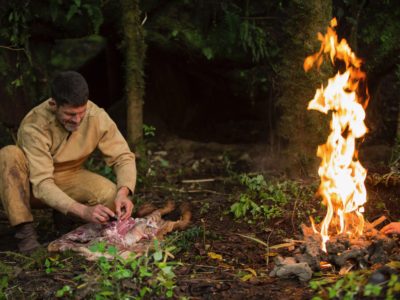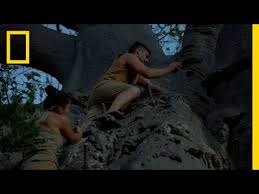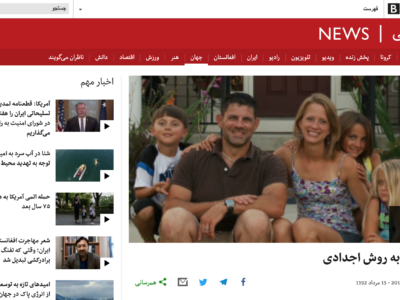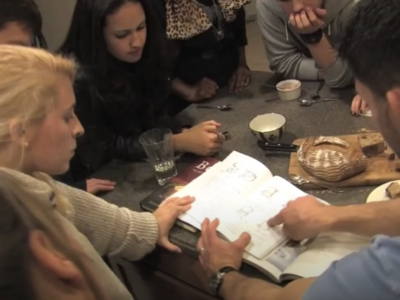You found the ideal spot if you want to feel like you are sitting in Dr. Bill’s classroom or part of the audience as he’s on the stage sharing his #EatLikeaHuman message
You also will find a bunch of family videos from our year abroad, so you can be transported to Germany as we ate Würchwitzer Mite Cheese or “enjoyed” an entire insect meal at Insects in the Backyard in Bangkok, Thailand. we guarantee – there are gems here to enhance your #eatlikeahuman journey whether you are just starting out (Eat Bread Like a Duck) or want to deepen your primitive tech schools (Basic Instinct Series by Wired). What are you waiting for? Join Dr. Bill’s virtual classroom now and learn how to Eat Like a Human!
How to Eat Food that Works for Humans! | The Doctors
How does archeology play a role in our diets? Archeologist, chef and author of “Eat Like a Human,” Bill Schindler joins The Doctors to share what the past can teach us about our modern diet. He shares …
What Did We Do Wrong With Dairy Products? | WIRED
The way that we produce and consume dairy today is nothing like it’s been for thousands of years. It has resulted in nutritionally inferior foods. The cows are fed differently, the milk is treated …
What Ancient Farmers Had Right About Corn That We Ignore | WIRED
Maize is one of the most widely grown grains in the world. The way that much of it is processed has contributed to making millions of people sick over the past 500 years. Dr. Bill Schindler talks …
We Ate Better 15,000 Years Ago – Here’s Why | WIRED
Dr. Bill Schindler explains why the processes we have in place today in the food industry lead to a less healthy and enriched lifestyle. The way humans eat animals has shifted. Our brains grew …
Ivor Cummins | Ep92 Professor of Anthropology Reveals the REAL Optimal Human Diet!
Podcast Episode 92 is a lively chat with my friend Dr. Bill Schindler, Associate Professor of Anthropology and Archaeology. Wow does he know the history of what determined the perfect human diet – and …
Dr. Bill Schindler’s Eat Like a Human Story
Learn about Dr. Bill Schindler’s Eat Like a Human journey and how he has struggled with his weight for his entire life until he realized the key to human health & diet is learning to #EatLikeaHuman
Eat Bread Like a Duck
Should humans eat bread?
I get asked this question All. The. Time.
Yes, you can eat bread! You just need to eat it like a duck 😉
The human body is not designed to eat grains – that is, at …
Basic Instincts | WIRED | How To Turn Garden Weeds Into Delicious Meals
You know those plants and weeds you see every day growing outside your home? They may not look like much, but if prepared properly, they can be transformed into a delicious and nutritious meal. Dr. …
Butchering 1/2 a pig in less than a minute!
Here is an empowering thought for all of you considering starting to butcher at home – there is no right or wrong way to do it! In fact, the only requirements are to be respectful and safe. …
The Making of a Wild Frittata: Forest to Fork
We spent the afternoon foraging for greens to fill a homemade frittata that evening for dinner. Perfect way to spend time together outside while creating a nutrient-dense dinner to keep us healthy …
Basic Instincts | WIRED | How to Make Stone Tools
If you’re in the wilderness and have nothing, perhaps the most important thing you need is a sharp, durable edge. Humans are among the weakest species on the planet and tools are what help us …
Basic Instincts | WIRED | How to Start a Fire in the Wilderness
Dr. Bill Schindler, a professor of archeology and anthropology at Washington College, demonstrates a couple of the most effective methods for starting a fire in the wilderness with limited resources.
FRUTO 2020 | The Modern Stone Age Diet: Our Dietary Past – The Technological Link between Nature, Man and Food
Bill is a gastronomic archaeologist, primitive technologist and chef. Travel the world documenting traditional forms of food and take inspiration from deep archaeological and ethnographic records, and …
Modern Stone Age Family by The Workshop on Curiosity Stream
Food Anthropologist Dr. Bill Schindler is on an international quest to discover what we should eat. He and his family uncover ancient culinary practices and show how they can bring simplicity and good …
Shaping sourdough bread for the kids’ lunches
Dr. Bill walks you through how to shape his fermented oatmeal bread in a pullman pan
Curiosity Stream | The Modern Stone Age Family
Food Anthropologist Dr. Bill Schindler is on an international quest to discover what we should eat. He and his family uncover ancient culinary practices and show how they can bring simplicity and good …
The Great Human Race Season 1 On-Demand Download
Two adventurers journey across the globe and follow in the footsteps of the earliest humans in order to test if modern man has what it takes to survive as our primitive ancestors did.
Maryland Public TV | Eastern Shore Food Lab
A plan for the Ellicott City flooding, plus, visiting Washington College’s Eastern Shore Food Lab.
CNN | Moths, Berries, Waterfalls: Hiker found alive after 17 days
Bill talks to CNN reporter Brooke Baldwin concerning hiker. Amanda Eller, surviving 17 days in the thick forest of Hawaii.
Chestertown Spy | Mid-Shore Food: Back to the Beginning in WC’s Food Lab with Dr. Bill Schindler
Perhaps the most the general public knows about Washington College’s Eastern Shore Food Lab, at least until recently, was its dubious distinction as being the entity that replaced the beloved Blue …
Prof. Bill Schindler – Are We Designed to Eat Meat?
Prof. Bill Schindler talks to us about the complicated subject of what humans are designed to eat. The answer is pretty surprising.
Portions of this will appear in the feature-length documentary …
Quesillo Making in Oaxaca
Thanks to @siddhartaltamirano for creating this video when our family visited expert quesillo maker, Silvia, in Oaxaca, Mexico! We began with fresh raw milk still warm from the cow, fermented it using …
The Atlantic | Food Evolution Revolution: The Cutting Edge Fusion of Archaeology, Anthropology and the Modern Kitchen
Archaeologist-Chef Dr. Bill Schindler, Founder and Director of the Eastern Shore Food Lab, talks to Steve Clemons, Washington editor at large of The Atlantic and editor of Atlantic LIVE.
Food Lies | Interview for Documentary
The full story is finally being told on what humans are supposed to eat, where we went wrong in the past 60 years, and how to fix this all.
Kissing the Blarney Stone
We headed to Blarney Castle and all had a chance to get the gift of gab (like any of us need it) by kissing the Blarney Stone! We had no idea that we would be suspended over an opening and have to …
Big Week on the Farm: RTÉ One | Bill Schindler shows Nose2Tail Eating
Dr. Bill Schindler had a chance to talk about ancestral diets and the importance of nose-to-tail approach to eating. He shared some of his creations including head cheese, pâté wrapped caul fat and …
Big Week on the Farm: RTÉ One | Bill Schindler talks about meat in our diet
A closer look at some of the developments in meat technology, as this year’s host farmer Gillian O’Sullivan travels to The Netherlands to check out the world’s first test tube burger. Then Dr. Bill …
Your Are What You Eat on RTE1 | Discusses implications of eating meat on vegan episode
Having tried the Paleo Diet in Season 1 and a High Protein Gym Diet in Season 2, this season presenter Philip Boucher-Hayestakes on the challenge of trying the now very fashionable vegan diet for a …
Finding the Fairy Tree
A day off from school for Alyssa means an adventure to find a Fairy Tree at Marley Park in Dublin, Ireland
Insects in the Backyard
Delicious dinner at Insects in the Backyard highlighting Entomophagy in Bangkok, Thailand! See the gourmet menu we enjoyed!
Beast from the East hits Ireland!
This year, we are so lucky to be living in Airfield Estate in Dublin, Ireland. When “The Beast from the East” snow storm hit in February though, we needed to head out and make sure the grounds and …
Dragon Breath Candy from Thailand!
We visited a night market in Bangkok and stumbled upon this candy powered by liquid nitrogen! So much fun and super cold!!
My Maps for Google
Creating a shared My Map for Google makes travel planning so much easier because you can truly see how long it will take to get from place to place!
Christmas Food Traditions in Ireland
Of all the things the kids wanted to continue this year was making and eating Monkey Bread and Biscuits & Sausage Gravy on Christmas Morning! Here’s a peek into making that happen!
Christmas Lights Turn on on Grafton Street in Dublin, Ireland
A magical moment to kick-off the holiday season as the lights turned on on Grafton Street in Dublin, Ireland!
Crossing the Atlantic in Northern Ireland Over the Carrick-a-Rede Rope Bridge!
The Modern Stone Age Family conquered the Carrick-a-Rede Bridge (66ft long and suspended 98ft over the Atlantic) in Northern Ireland. Fisherman used to travel this bridge (with only one side rail) to …
Washington College | Eastern Shore Food Lab Goes Abroad
Dr. Bill Schindler describes the scope of research that will guide the launch of the Eastern Shore Food Lab at Washington College.
Christmas Tree Surprise!
Christmas Tree Surprise from Airfield Estate and Howbert & Mays Gardens to The Modern Stone Age Family
Würchwitzer Mite Cheese Adventure
3 hours outside of Berlin we found the Würchwitzer Milbenkäse Cheese Museum, home to the infamous German Mite Cheese. Our whole family had a chance to see the mites up-close and then taste the cheese …
Washington Ideas | Interview with Ross Anderson
Dr. Bill Schindler, takes the stage with Ross Andersen, Senior Editor of The Atlantic to talk about what it means to eat like a human at the 2017 Washington IDEAS conference.
Washington College | Eastern Shore Food Lab
Dr. Bill Schindler introduces the Eastern Shore Food Lab at Washington College. http://www.washcoll.edu/foodlab
WBALTV | Crunch! Dr. Bill has Jennifer try a cricket dish
Bill Schindler, with Washington College, talks about insect food and Jennifer Franciotti takes a bite.
Washington College | Experimental Archaeology in Cromwell Hall
Students in Dr. Bill Schindler’s Experimental Archaeology class describe the learning experience in Cromwell Hall. http://www.washcoll.edu
National Geogrpahic | The Great Human Race: SEASON 1
Two and a half million years ago our ancestors left the trees and ventured out into the planet’s harshest terrains. For millions of years we withstood droughts and ice ages to not only survive, but …
National Geographic | The Great Human Race: PIONEER
Bill and Cat follow in the footsteps of the first Americans who migrated south into the Pacific Northwest. Navigating a separate land and sea route, their goal is to unite on the coast and head …
The Great Human Race | National Geographic | Entering a Salmon Graveyard
Cat and Bill finally make it to the salmon spawning grounds but initially only find dead fish. Thinking they’re too late, they come across a shallow pool filled with fish. But salmon are virtually …
The Great Human Race | National Geographic | Two Routes to the Americas
Cat and Bill split up and take an inland and coastal route that early humans used to get to the Pacific Northwest. The plan is to meet up at the mouth of a river and take advantage of the annual …
National Geographic | The Great Human Race: 1ST AMERICANS
Bill and Cat follow in the footsteps of the first Americans to cross the Bering Land Bridge 15,000 years ago. Their trek begins in the Alaskan tundra, where a winter storm beats down upon them. In …
National Geographic | The Great Human Race: HERD
Bill and Cat attempt to survive as nomadic herders in Mongolia 5,000 years ago. To keep their animals alive, they must move the herd to its summer camp before the cold winter weather moves in. As the …
The Great Human Race | National Geographic | Sparking a Fire
To survive the freezing weather, Bill and Cat use special tools to get a a fire started.
National Geographic | The Great Human Race: ICE
Bill and Cat attempt to survive as mobile hunters living in Siberia during the peak of the Ice Age. Plant life is sparse, and the only hope for the survival is to track and kill big game. They begin …
The Great Human Race | National Geographic | Wolf Scraps for Dinner
Bill and Cat find a pack of wolves ripping a yak carcass apart and wait their turn to pick at the remains.
National Geographic | The Great Human Race: CAVE
Bill and Cat attempt to find shelter along the Caucasus Mountains, a journey some of our ancestors made to escape the bone-chilling temperatures of the Ice Age 40,000 years ago. First, they make …
National Geographic | The Great Human Race: ADRIFT
On this leg of their journey, Bill and Cat’s mission is to overcome the barrier of the sea and expand into new lands. They begin in a resource-barren marsh in Southeastern Turkey, where the pair slogs …
The Great Human Race | National Geographic | Constructing a Reed Boat
The tension rises as Bill and Cat construct their boat.
The Great Human Race | National Geographic | Wading Through a Swamp
Bill and Cat struggle through an unforgiving swamp of tall cattails.
National Geographic | The Great Human Race: THIRST
Bill and Cat follow in the footsteps of early Homo sapiens as they make their way through the Arabian Desert – the second largest in the world. Their mission is to locate dried riverbeds and follow …
The Great Human Race | National Geographic | Scorpion Kill Survival Skills
Bill and Cat pry a scorpion out from under a rock and manage to kill it for a meal.
National Geographic | The Great Human Race: HUNT
Following in the footsteps of the first Homo sapiens, Bill and Cat attempt to hunt big game in the mountains of Ethiopia. The journey begins in a lowland valley, where Bill and Cat fail in their …
The Great Human Race | National Geographic | Waste Not, Want Not
Bill and Cat stumble upon a dead baby bushbuck and harvest it for resources.
National Geographic | The Great Human Race: FIRE
Bill and Cat follow in the footsteps of Homo erectus as they journey into the jungles of Uganda. Of all the achievements of Homo erectus, the most notable was their ability to control one of nature’s …
The Great Human Race | National Geographic | From the Hunted to the Hunter
Cat and Bill are on the hunt for their next meal. Armed with primitive weapons, they follow the evolution of Homo Erectus from being hunted, to becoming the hunter.
The Great Human Race | National Geographic | A Scare in the Night
Cat and Bill build a fence of acacia thorns around the fire and hope that the 3 inch thorns will ward off any predators. As they settle in for the long night on the ground, they are visited by the …
National Geographic | The Great Human Race: DAWN
The savanna of East Africa. Every person can trace their roots here, the home of the one of the first members of the human species – Homo habilis. Archaeologist Bill Schindler and survival expert Cat …
The Great Human Race | National Geographic | Setting Up Camp in a Tree
Darkness is falling fast and the nocturnal predators are stirring. Cat and Bill must get off the ground and up into a thousand year old Baobab tree in order to survive their first night on the …
The Great Human Race | National Geographic | Bringing the Meat to Higher Ground
Dehydrated and starving, Cat and Bill come across a fresh lion kill and rush to cut away as much meat and bone as they can carry before the predators that made the kill return.
Washington College | Unhurried: Primitive
Dr. Schindler’s Experimental Archeology class not only shows students how to look for clues from archaeological evidence, but has them making tools and processing food for a hands-on experience in …
University College Dublin | How to Better Teach Students who Live in an Increasingly Compartmentalized World
Keynote address – Soul Authorship: experimental archaeology, and the value of authentic learning experiences in Higher Education pedagogy.
Washington College | Convocation Address as 2014 Alumni Award for Distinguished Teaching
Professor William Schindler’s Convocation Address at Washington College’s 2014 Fall Convocation. Prof. Schindler is the 2014 Alumni Award for Distinguished Teaching recipient.
BBC | Cómo alimentarse de lo que crece en los parques. (BBC Mundo video coverage of an urban foraging tour conducted in Washington D.C.)
Running away from processed foods with their additives, pesticides, hormones and preservatives, every day there are more people looking for alternatives to supplement their diet.
Washington College | Interpreting the Past
Professor of Anthropology Bill Schindler led students on a three-week summer immersion course that culminated by living in a reconstructed Iron Age village.
BBC Persia | Hunting in the Primitive Way.
Trying to “bring a piece of bread to the table” can sometimes literally mean hunting, farming and baking.
In this week’s world, Sam Farzaneh went to an American man who wants to prepare his family …
BBC Persia | The World is my Salad Bowl
That is, if Baba Tahir looked naked in the desert, he saw his friend, and when he looked at the sea, he saw his friend again, and in short, when he looked at the mountains and the door and the plain, …
BBC Persia | Living Like our Ancestors in the 21st Century
Most people in the world go to the shops to buy food, but there are still some who still prefer to find their food in the plains and forests. One of these people is William Schindler; University …
Washington College | Food, People, & the Planet Video
Washington College Professor of Archaeology and Anthropology Bill Schindler took students on a culinary adventure through international cultures in his course “Food, People, & the Planet.” Students …
Washington College | Quick Overview of Making Kimchi
Dr. Bill Schindler demonstrates how to prepare kimchi as part of a traditional meal in his “Food, People, & the Planet” class.
Washington College | Quick Overview of Making Mustard
Dr. Bill Schindler demonstrates how to make mustard as part of a traditional meal in his “Food, People, & the Planet” class.
Washington College | Quick Overview of Making Head Cheese
Dr. Bill Schindler demonstrates how to prepare head cheese as part of a traditional meal in his “Food, People, & the Planet” class
Washington College | Beer Bottling for “Food, People, and the Planet” Class
Dr. Bill Schindler demonstrated how to siphon home-brewed beer from carboys, add sugar to produce carbonation, and bottle the beverages in preparation for a multi-course meal in his “Food, People, & …
Washington College | Pig Butchering for “Food, People, & The Planet” Class
Dr. Bill Schindler teamed up with Kevin McKinney, Chef/Owner of Brooks Tavern in Chestertown, to demonstrate how to butcher a pig in preparation for a multi-course meal in his “Food, People, & The …
Washington College | Quick Overview of Camembert Cheese Making
Dr. Bill Schindler introduces students to Camembert cheese making, the first dish prepared as part of a multi-course meal in his “Food, People, & The Planet” class at Washington College.
Washington College | Experimental Archaeology: Stone Tools in Food Production
Assistant Professor of Anthropology Bill Schindler shows Washington College students in his Experimental Archaeology class how to use primitive technology in food production by making stone tools and …




